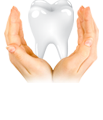Teeth Whitening
Your smile is one of the first things people notice about you and the best tool you have for welcoming them into your life. A sunny smile is so important that teeth whitening is the most popular cosmetic procedure performed by Modern Age Dentistry. Whiter teeth immediately enhance your appearance and change how others interact with you.
Teeth turn darker over time, due to cumulative stains and natural changes as pulp in the center of your teeth darkens. Colored pigments in coffee, tea, red wine, and tobacco products are the top causes of gradual teeth staining. Acidic foods and drinks, such as carbonated beverages, also make it easier for pigments to seep into your teeth as they erode the enamel.
There are two main ways a dental professional can provide treatment to whiten teeth - 'in-chair' or 'take-home' whitening.
Professional, in-office teeth whitening is the most popular cosmetic dental procedure in the world today. Unlike home-use systems that incorporate low-dose bleaching agents, in-office whitening takes place under carefully monitored conditions which allow for the safe, controlled, pain-free use of a relatively high concentration of bleaching gel - yielding results that are visible immediately.
In-office bleaching is not a permanent solution. Shortly after treatment is completed, the teeth resume accumulating stains. Many dentists therefore recommend home maintenance follow-up with a lower-percentage bleach that can be kept on the teeth for longer periods of time.
Advantages
- Produces fastest results.
- This is the safest form of bleaching.
- Gum and tooth sensitivity (formerly drawbacks to in-office bleaching) are more controllable today due to thicker peroxide gels (that don't soak into the teeth as much as previous gels) and the use of desensitizers such as potassium nitrate and fluoride.
- More expensive than take-home alternatives.
- Results can be unpredictable, depending on factors such as age, heredity and the type of staining that is present.
You can get professionally produced whitening kits that you can administer to yourself. This take-home whitening gel offers sustained whitening power in the comfort of your own home. The whitening gel comes in syringes and is delivered via custom trays made in our office. It is placed into the custom bleaching trays that are then inserted into the mouth. This gel is only dispensed by a dentist and comes in formulations of 35% and 10% carbamide peroxide with wear times from 30 minutes to overnight.
This method of teeth whitening is safe as long as you follow the directions and don't keep the trays in longer than is recommended. The results are excellent.
This can be convenient because you do not have to schedule time to go to the dentist, but it can also be cumbersome because walking around your house with bleaching trays in your mouth is distracting and uncomfortable.
The two main products used for teeth whitening are hydrogen peroxide and carbamide peroxide. Unlike a whitening toothpaste that uses an abrasive ingredient to mechanically remove surface-level stains, the oxygen molecules within these whitening agents weaken your tooth stains on a molecular level.
While teeth whitening is generally considered safe, some people wonder if it can make their teeth weaker, or if the chemicals are bad for them.
There may be a temporary teeth sensitivity in the form of short sharp pains in response to hot or cold foods and drinks, and usually occurs shortly after bleaching agents are applied.
If whitening products are overused or used incorrectly, the peroxide in the whitening gel can cause teeth sensitivity and in some cases gum irritation which is transient.
Discomfort resulting from teeth whitening is usually temporary, lasting no longer than two days. To reduce sensitivity after whitening, individuals can:
Take over-the-counter pain relievers
- Use sensitive toothpaste
- Brush gently
- Stick to room temperature foods and drinks
- Take over-the-counter pain relievers


